AMD Radeon HD 7950 Review Feat. Sapphire & XFX: Sewing Up The High-End Market
by Ryan Smith on January 31, 2012 9:02 AM ESTPower, Temperature, & Noise
As always, we wrap up our look at a new video card with a look at the physical performance attributes: power consumption, temperatures, and noise. With the 7970 we saw what is possible with Tahiti when AMD is trying to maximize their performance, but how will things stack up with the lower power 7950? Let’s find out.
Please note that we’ve decided to include our reference 7950 in these charts, even though none of AMD’s partners will be shipping a card in this exact configuration. Typically we wouldn’t do this, but as our partner cards are overclocked it’s the only stock performance card we have. Furthermore it provides an interesting contrast to the 7970, since they’re built on the same hardware. With that said, the Sapphire and XFX cards are far more representative of the cooling performance you’ll see with retail cards.
| Radeon HD 7900 Series Voltages | |||||
| Ref 7970 Load | Ref 7950 Load | XFX 7950 Black Edition DD | Sapphire HD 7950 Overclock Edition | ||
| 1.17v | 1.093v | 1.093v | 0.993v | ||
Since the launch of the 7970 we’ve finally seen the release of tools that can read the VIDs of Tahiti GPUs. For our review we have four 7950s in our hands, and one of them is not like the others. Both of our AMD cards and our XFX card have a VID of 1.093v, however the Sapphire card is significantly lower. So low that we thought this was an error and went through 3 different tools just to be sure it wasn’t. Sure enough, our Sapphire 7950 does indeed ship at 0.993v, roughly 0.1v below our other 7950s and lower than what we thought Tahiti could operate at. The fact that the Sapphire is overclocked makes this all the more impressive, and we’ll see how this plays out in a moment.
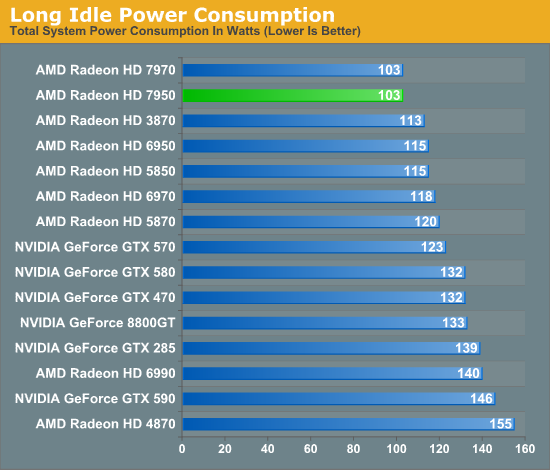
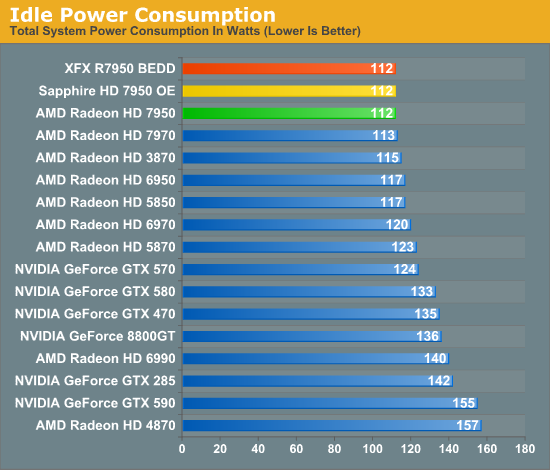
Starting as always with idle power, there aren’t many surprises here. Power islands not only give the 7000 series great idle power characteristics, but they also greatly diminish the difference between GPUs when it comes to idle power consumption. As a result the entire 7950 lineup is at 112W at the wall, consistently 1W below the 7970 and a good 20W below the GTX 580.
The situation with long idle power is much the same. As AMD’s ZeroCore power technology effectively powers down all the workhorse components of the GPU, the only thing left is a small constant load from the bus controller, giving us 103W on both the 7970 and 7950.
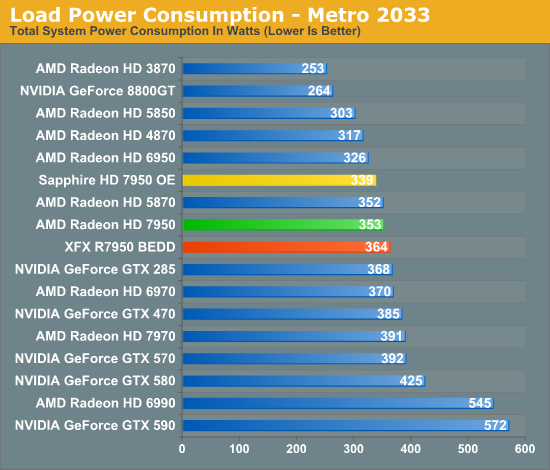
Meanwhile it’s under load that the physical performance attributes of the 7950 really begin to shine. Compared to the GTX 580, our 7950 equipped testbed draws 72W less at the wall; the performance advantage we saw in Metro earlier makes this all the more impressive. The 7950 also pulls less power than the 7970 here as we’d expect, leading to a difference of 38W at the wall.
As for our two partner cards, the Sapphire does particularly well here thanks to its very low VID, while the XFX does a bit worse than the reference 7950, likely due to its stock VID coupled with the factory overclock.
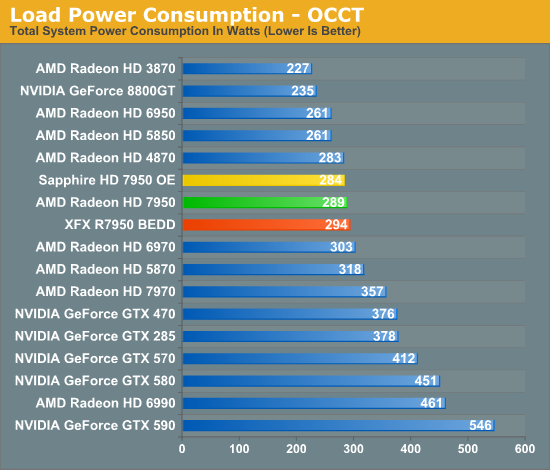
Under OCCT our 7950 cards begin to clump together in spite of their differences. With the reference 7950 at 289W, the Sapphire and XFX cards pull 5W less and 5W more respectively. It’s interesting to note here that as with the 7970 compared to the 6970, the 7950 is pulling more power than the 6950 even though both cards should have the same PowerTune limit. In practice it’s clear that the 7950 is more power hungry than the 6950 despite the PowerTune limit, so this needs to be taken into account accordingly.
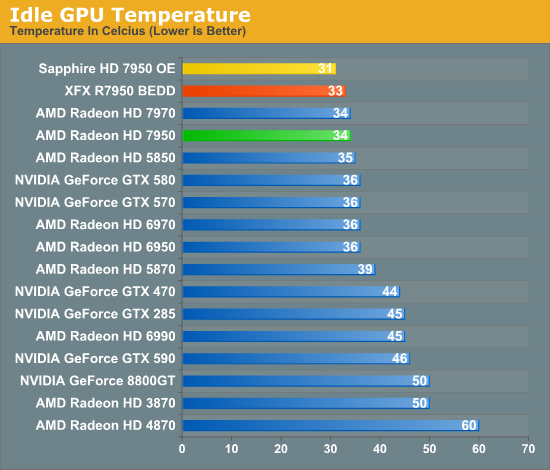
As the use of power islands has brought down the idle power consumption, so has it brought down idle temperatures. The 7970 already did well here and the reference 7950 does similarly well, while the open air coolers on the XFX and Sapphire cards take this one step further, pulling temperatures down to 33C and 31C respectively.
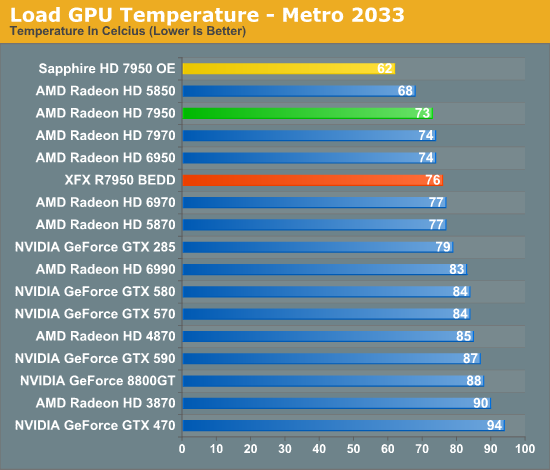
Meanwhile load temperatures are a mixed bag among the 7950s, and it’s not all good. Starting with the Sapphire 7950, we have an open air card with a very low VID that’s performing as we’d expect. The Sapphire card is extremely cool here, and this kind of gap is consistent with other near-200W cards we’ve seen in the past. Elsewhere, in the middle is the reference 7950, which is using AMD’s fully exhausting blower; this pushes almost all the heat outside of our case, but it does keep temperatures higher, and in this case very close to the 7970.
Finally we have the XFX card, which is the odd man out. The R7950 BEDD is an open air cooler and we’d expect performance closer to the Sapphire card, not performance worse than the reference 7950.

Under OCCT the results closely mirror what we saw with under Metro. The Sapphire is well in the lead among the 7950s, followed by the reference and XFX cards. With virtually every other card pushing 80C or higher, the 7950s are in good company here, particularly compared to the 88C GTX 580 due to the lack of comprehensive power throttling on NVIDIA’s part.
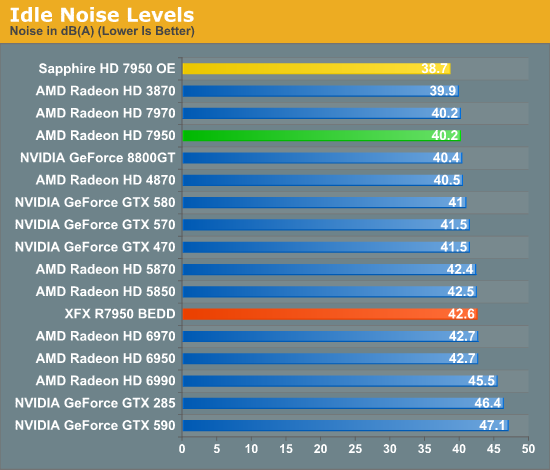
Last but not least we have our look at noise. The 7970’s cooler was already doing quite well at 40.2dB, but Sapphire takes this one step further with their open air cooler, bringing their idle noise down to 38.7dB. XFX on the other hand doesn’t fare as well, as their Double Dissipation cooler can’t rev down quite enough, coming in louder than the reference 7950 at 42.6dB.

It’s looking at load noise that particularly drives home the potential of the Sapphire 7950. Sapphire has exploited their open air cooler for all it's worth, and as a result it’s quieter under load with Metro than half our cards are at idle—41.3dB is only 0.3dB louder than the GTX 580 at idle, never mind the other 7950s. The XFX meanwhile fares really, really poorly here for an open air cooler. This doesn’t appear to be a matter of an aggressive fan profile as we’ve already seen that its temperatures are close to the reference 7950, so there’s more going on here.

Even under OCCT the Sapphire 7950 still only hits 42.8dB, a particularly impressive showing when you consider that AMD’s reference 6900 series cards idle at 42.7dB. It’s not a silent card, but for most practical purposes it’s damn close. Meanwhile the XFX 7950 again fares poorly, coming in at 56.8dB. This is still quieter than the GTX 580 in this case, but it’s clearly disappointing.
Wrapping things up, as we stated in our introduction the vast selection of 7950s means that there’s going to be a wide range of performance for 7950 cards, and these results drive home the point nicely. The Sapphire 7950 simply gushes potential—not only is it a factory overclocked card, but it gives off so little heat and noise compared to anything else in its performance class that it’s unrivaled. Much of this no doubt is due to the extremely low VID of our sample and I strongly suspect that this a better voltage than the bulk of Sapphire 7950s can actually hit, so our results are most likely better than average. Still, even with more voltage there’s still plenty of thermal and acoustic headroom for the Sapphire 7950 to work with, so it should still be a well performing card regardless.
Overall it’s results like what we’ve seen with the Sapphire that are a large part of why AMD’s partners are strongly favoring open air coolers. But with that said, that potential can only be reached in a case with good airflow, meaning that the Sapphire 7950 (or any other open air 7950 for that matter) is likely a poor choice for a cramped case. Furthermore all of these open air cards are poor choices for CrossFire if they need to be directly adjacent to each other. A lot of boards offer usable PCIe x16 slots farther away from their first x16 slot, but this is not the case for all boards. Ultimately the lack of 7950 cards using a fully exhausting blower is definitely going to limit the CrossFire potential of the 7950.
Finally, we have the XFX 7950 BEDD. The 7970 BEDD was a very impressive card; the 7950 BEDD is not. It’s not possible to completely isolate any specific reason for the 7950 BEDD’s poor performance, but the most likely factors are the GPU quality and the ability of the card to transfer heat between the GPU and heatsink. With regards to quality, if the Sapphire 7950 has among the best 7950 GPUs then the 7950 BEDD has an average GPU if not worse; 1.093v is the same as our reference cards, but there’s still room for quite a bit of variance. Whereas when we’re looking at heat transfer we have to look at the much smaller vapor chamber the 7950 BEDD uses compared to the 7970 BEDD, along with what at first glance looks like too much thermal paste.
Given our temperature and power consumption data we’re heavily favoring the heat transfer theory; the 7950 BEDD just isn’t very good at transferring heat from the GPU. This is not to say that the 7950 BEDD is a bad card—our results are reasonable for a 200W card—but we’ve seen much better in the 7970 BEDD, never mind the other 7950 cards.










259 Comments
View All Comments
nissangtr786 - Wednesday, February 1, 2012 - link
At the end of the day the 7970 and 7950 are great cards. They are like going from a 65nm pentium 4 to a 45nm core 2 duo in terms of performance per watt. Yes AMD may have not cranked the power consumption like amd do but performance per watt or gflops per watt it is basically double or even better then the last generation 40nm cards.Imagine 10000 40nm gtx 580 running in the world or 10000 7950 running in the world. Saving 160w more each person with similar person. 160w is a lot of power enough to run nearly an m17x r3 with 6970m.
160w multiplied by 10000 people = 1600000 watt difference for same performance of a gtx 580 and 7950. Thats 1.6m watts in simple terms more to game. If process and architecture changes of cpus and graphics cards didn't happen we would still have pentium 4's running at 3.8ghz with 6800 utras taking nearly as much power to run as an i7 3960x and 7970. Also idle watts usage go down every die shrink.
JNo - Thursday, February 2, 2012 - link
I'm surprised you didn't give the Sapphire a Gold Editor's choice award.It is pretty much awesome in every respect and I don't see any drawbacks.
No I don't work for Sapphire but this is the card I'd buy tomorrow (if I really needed it/had more money!)
Finally - Thursday, February 2, 2012 - link
Sapphire did do their homework. I find it astonishing that they were the only ones to consider undervolting, while also overclocking their product. Hats off!chizow - Thursday, February 2, 2012 - link
No, Tahiti is competing with the expectations of a new generation of hardware, expectations they clearly failed to meet. You don't ask for flagship prices when all you bring to the table is refresh performance of 14 month old last-gen parts. If you don't think so, but hey np, I have a copy of Madden 2010 you can buy for $60.How are my expectations too high? More like your expectations are too low if you were impressed with Tahiti. 15-25% faster than the last-gen flagship? Is that a joke? Once again, next-gen expectations commanding flagship prices should be AT LEAST 50% before anyone considers buying. Y'know, the same speed bump that "clusterfk" Fermi was over the last-gen parts...... Once again low expectations of AMD fans just used to being mediocre I suppose....
And to disprove your nonsense again with historical fact, Nvidia did have the fastest card in 2010 with GTX 480, but instead of raising the prices, they kept it the same with the GTX 580. They've done this in the past as well with the GTX 280 > GTX 285. They don't raise prices on refreshes, they also don't raise prices on flagships on new generations because they learned their lesson with GTX 280 after the original pricing fiasco.
chizow - Thursday, February 2, 2012 - link
Wrong again.The rebates were funded by Nvidia for price protected "exclusive" partners in NA and EU markets. At the time, that was EVGA, BFG and XFX.
The partners only sent out the rebate because they received the bulk of payment after shipping to retailers, but only with Nvidia's green light. Nvidia also directly funded/reimbursed or promised more inventory using the credited difference for any existing stock in the channel when they officially dropped the price of the GTX 280 from $650 to $500 and the GTX 260 from $450 to $350. Prices on the top two cards have stayed virtually the same since.
But yes, AMD is setting themselves up for a similar fall. If they priced the 7970 the same as the previous flagships, $500. No one would care that much. If they priced the 7950 the same as their previous 2nd tier, $380-400. No one would care that much.
But they got greedy. For what? 15-25% improvement on a new architecture, full node, and 14 months? History is due to repeat itself, and not in AMD's favor. At least in Nvidia's case, the GTX 280 actually warranted its pricetag relative to last-gen parts. You can't even say that about the 7970.
chizow - Thursday, February 2, 2012 - link
Well if a $300 card is priced where it should be and performs the same as AMD's $450 card something will certainly have to budge.Unless Nvidia decides to just refresh their old parts on 28nm and prices everything the same for a 5-10% increase in performance.
In that case, we can all just not buy video cards this generation because nothing will be worth buying and we can stop pretending these new cards are some awesome new innovation.
chizow - Thursday, February 2, 2012 - link
They're still $500 because demand is still strong, its close to EOL, and people still find value in Nvidia parts over AMD.They'll drop the prices to sell off the last few in the channel when they replace the part with something better, but in the meantime, AMD hasn't given any reason for them to slash the prices due to their greedy pricing on the 7950.
Again, this is a departure from past launches where AMD did price their parts sensibly and forced Nvidia to lower prices on its flagship cards (GTX 285 etc).
4 of 11 out of stock is good? After 4 days on the market? I don't think so. I think the market has spoken given every other major launch in the last few years on a high-end SKU like this has resulted in OOS for about a month.
Demand for this part is soft, and at its price/performance that's no surprise and really shouldn't be.
chizow - Thursday, February 2, 2012 - link
Really? So being the highest-end SKU that AMD produced and within 10-15% of the fastest single-GPU on the planet, it wasn't a high-end card? And I guess AMD didn't have any high-end cards that generation?And "pricing ALWAYS based on performance relative to the competition". So the RV770 coming within 10-15% of the GTX 280 which already launched for $650 and was selling briskly because it deserved that pricing relative to last-gen (9800GX2, 8800GTX) and AMD pricing this part for $299 made sense based on performance relative to the competition? Really?
You're wrong. Stop posting LMAO. RV770 was a price mistake on AMD's part, a mistake they've been trying to correct ever since. Now Nvidia has a chance to return the favor because the 7970/7950 are going to be in a similar position due to the fact they're mispriced based on last-gen metrics.
chizow - Thursday, February 2, 2012 - link
Newsflash: if you want the newer part, you actually expect better performance for the same price compared to parts that have been out for over a year.Welcome to my used car lot where I sell old cars for brand new prices.
chizow - Thursday, February 2, 2012 - link
And that's exactly what's wrong with their pricing, an error that will be obvious once its competing against the products its supposed to be competing with.By your same flawed logic, graphics cards would be thousands of dollars as every incremental increase would incur an increase in price without limits.